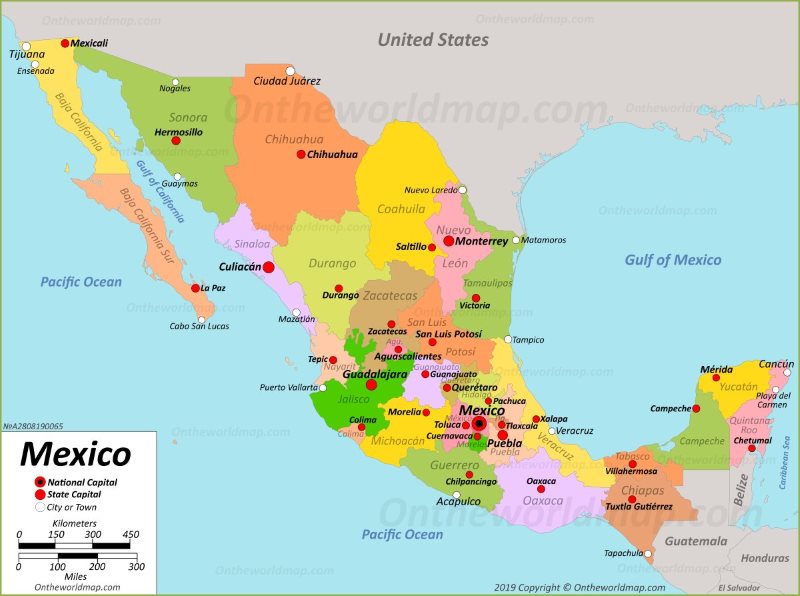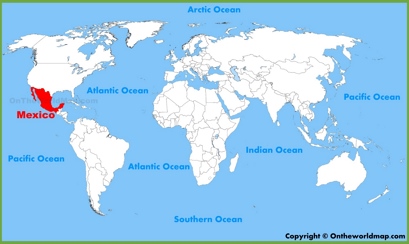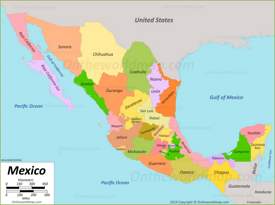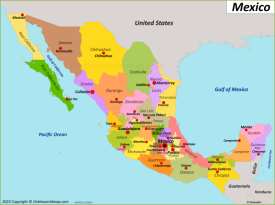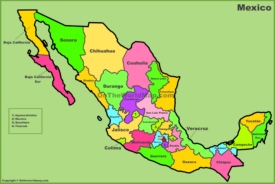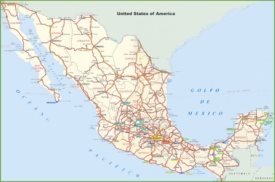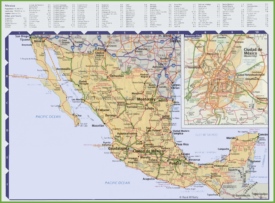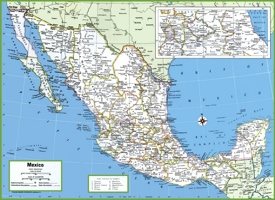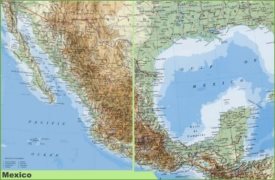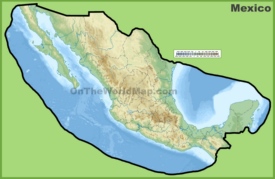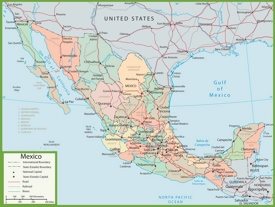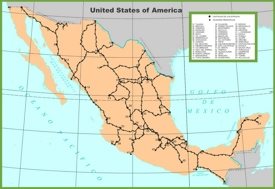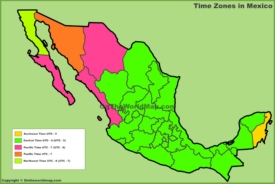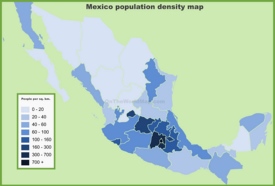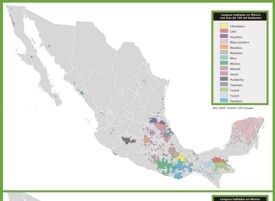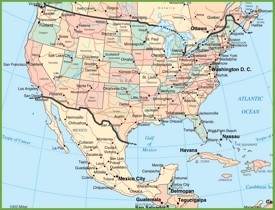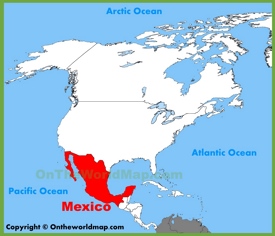Mexico Map
Description:
This map shows governmental boundaries of countries; states, state capitals and major cities in Mexico.
Size: 1400x1042px / 310 Kb
1200x894px / 145 Kb
Author: Ontheworldmap.com
You may download, print or use the above map for educational, personal and non-commercial purposes. Attribution is required. For any website, blog, scientific research or e-book, you must place a hyperlink (to this page) with an attribution next to the image used.
Online Map of Mexico
Detailed Maps of Mexico
About Mexico
Mexico, officially the United Mexican States, is located in the southern part of North America. It is bordered by the United States to the north, Belize and Guatemala to the southeast, and has a coastline on the Pacific Ocean to the west and the Gulf of Mexico and Caribbean Sea to the east. Covering an area of about 761,610 square miles (1,972,550 square kilometers), Mexico is the 14th largest country in the world by land area. Recent estimates put Mexico's population at over 129 million, making it the 10th most populous country in the world.
Mexico City, the capital, is the political, economic, and cultural center of the country. Other major cities include Guadalajara, Monterrey, Puebla, and Tijuana, each of which contributes significantly to the national economy and regional development.

Mexico's economy ranks 15th in the world in terms of nominal GDP. It is a mixed economy with key sectors including manufacturing, oil and gas, agriculture and services. The country is a leading exporter of automobiles, electronics and agricultural products. In addition, Mexico is a member of international organizations such as the United Nations, the World Trade Organization and the Organization for Economic Cooperation and Development.
Tourism plays an important role in Mexico's economy, attracting millions of visitors each year. Tourists come to cities such as Cancun, Playa del Carmen and Los Cabos to enjoy their beaches, while Mexico City and Oaxaca offer rich historical and cultural experiences. The country's diverse ecosystems and archaeological sites, including Chichen Itza and Teotihuacan, further enhance its appeal.
Despite the strength of the economy, Mexico faces challenges such as income inequality, security issues, and political corruption. The government continues to implement reforms to address these challenges in an effort to achieve sustainable development and improve the quality of life for its citizens. Mexico's strategic location, economic potential and cultural heritage make it an important player on the world stage.
The Facts:| Capital: | Mexico City |
| Area: | 761,610 sq mi (1,972,550 sq km) |
| Population (2023): | 129,875,529[1] |
| Official language: | Spanish |
| Religion: | 56% Roman Catholic 17% No religion 10% Protestant 7% Other 5% Other Christian 5% Prefer not to say 1% Muslim |
| Currency: | Peso (MXN) |
| Driving side: | right |
| Calling code: | +52 |
| Internet TLD: | .mx |
| Time zone: | UTC−8 to −5
Summer (DST) UTC−7 to −5 |
| Official government website: | www.gob.mx |
| Official tourism website: | visitmexico.com |
Google Map of Mexico
List of Largest Cities in Mexico
- Mexico City (9,250,000)
- Tijuana (1,900,000)
- Ecatepec (1,640,000)
- León (1,600,000)
- Puebla (1,550,000)
- Ciudad Juárez (1,550,000)
- Guadalajara (1,380,000)
- Zapopan (1,270,000)
- Monterrey (1,145,000)
- Nezahualcóyotl (1,075,000)
- Toluca (990,000)
- Chihuahua (935,000)
- Mérida (930,000)
- Naucalpan (910,000)
- Cancun (900,000)
- Saltillo (875,000)
- Aguascalientes (870,000)
- Hermosillo (865,000)
- Mexicali (865,000)
- San Luis Potosí (855,000)
- Culiacán (820,000)
- Querétaro (800,000)
- Morelia (755,000)
- Chimalhuacán (710,000)
- Reynosa (695,000)
- Torreón (691,000)
- Tlaquepaque (660,000)
- Tlalnepantla (659,000)
- Acapulco (658,000)
- Guadalupe (630,000)
- Durango (620,000)
- Tuxtla Gutiérrez (580,000)
- Cuautitlán Izcalli (560,000)
- Ciudad Apodaca (540,000)
- Veracruz (535,000)
- Ciudad López Mateos (525,000)
- Matamoros (515,000)
- General Escobedo (465,000)
- Irapuato (460,000)
- Mazatlán (450,000)
- Xalapa (445,000)
- Tonalá (443,000)
- Nuevo Laredo (420,000)
- San Nicolás (410,000)
- Ojo de Agua (395,000)
- Xico (385,000)
- Celaya (380,000)
- Ixtapaluca (375,000)
- Tepic (372,000)
- Cuernavaca (342,000)
- Villahermosa (340,000)
- Ensenada (340,000)
- Ciudad Victoria (333,000)
- Ciudad Obregón (330,000)
- Ciudad Nicolás Romero (325,000)
- Ciudad Benito Juárez (320,000)
- Playa del Carmen (320,000)
- Soledad (315,000)
- Santa Catarina (305,000)
- Gómez Palacio (305,000)
Tourism in Mexico
Tourism in Mexico is an important component of the national economy, and the country itself ranks among the top tourist destinations in the world. The tourism sector benefits from the diversity of Mexico's offerings, from pristine beaches and vibrant cities to historic sites and natural wonders.
Major coastal resorts such as Cancun, Playa del Carmen and Los Cabos attract tourists seeking sun and relaxation. These places offer luxury accommodations, water sports and nightlife, targeting both international and domestic travelers. Riviera Maya, stretching along the Caribbean coast, offers access to coral reefs and cenotes, increasing its appeal to adventure seekers.

The capital city of Mexico City serves as a cultural and historical center. Visitors can visit its museums, such as the National Museum of Anthropology, and attractions such as the Zocalo and Chapultepec Castle.
Archaeological sites play a crucial role in Mexican tourism. Chichen Itza, Teotihuacan and Palenque showcase the remains of ancient civilizations, attracting history buffs from around the world. Recognized as UNESCO World Heritage Sites, these sites provide a glimpse into Mexico's rich pre-Columbian past.
Ecotourism also contributes to Mexico's tourism sector, with regions such as the Yucatán Peninsula and Baja California offering opportunities for wildlife watching and nature study. Activities such as whale watching, bird watching, and hiking attract environmentally-conscious travelers.
The Best Beach and Coastal Towns in Mexico: Cabo San Lucas, Puerto Vallarta, Cancun, Riviera Maya, Oaxaca, Los Cabos, Cozumel, Tulum, Playa del Carmen, Isla Mujeres, Puerto Morelos, Punta Mita, Playa Los Cerritos, La Paz, Rosarito, Akumal, Playa del Amor, Costalegre, Bacalar, Loreto, El Cuyo, Puerto Progreso, Mahahual.
Main sights in Mexico: Chichén Itzá, Teotihuacan, Cabo San Lucas, Mexico City Metropolitan Cathedral, Zócalo, Guanajuato, Cozumel, Tulum, Ixtapa, Guadalajara, Palenque, Acapulco, Playa del Carmen, Copper Canyon, Cancun, Puerto Vallarta.
States of Mexico
| State | Capital | Area | Population |
|---|---|---|---|
| Aguascalientes | Aguascalientes | 2,168 sq mi (5,616 sq km) | 1,470,000 |
| Baja California | Mexicali | 27,587 sq mi (71,450 sq km) | 3,830,000 |
| Baja California Sur | La Paz | 28,537 sq mi (73,909 sq km) | 765,000 |
| Campeche | San Francisco de Campeche | 22,195 sq mi (57,485 sq km) | 970,000 |
| Chiapas | Tuxtla Gutiérrez | 28,306 sq mi (73,311 sq km) | 5,620,000 |
| Chihuahua | Chihuahua | 95,527 sq mi (247,413 sq km) | 3,820,000 |
| Coahuila | Saltillo | 58,531 sq mi (151,595 sq km) | 3,200,000 |
| Colima | Colima | 2,173 sq mi (5,627 sq km) | 840,000 |
| Durango | Victoria de Durango | 47,631 sq mi (123,364 sq km) | 1,860,000 |
| Guanajuato | Guanajuato | 11,817 sq mi (30,607 sq km) | 6,215,000 |
| Guerrero | Chilpancingo de los Bravo | 24,555 sq mi (63,596 sq km) | 3,570,000 |
| Hidalgo | Pachuca de Soto | 8,039 sq mi (20,821 sq km) | 3,125,000 |
| Jalisco | Guadalajara | 30,346 sq mi (78,596 sq km) | 8,450,000 |
| México | Toluca de Lerdo | 8,630 sq mi (22,352 sq km) | 17,150,000 |
| Mexico City | Mexico City | 577 sq mi (1,494 sq km) | 9,350,000 |
| Michoacán | Morelia | 22,625 sq mi (58,599 sq km) | 4,760,000 |
| Morelos | Cuernavaca | 1,884 sq mi (4,879 sq km) | 2,030,000 |
| Nayarit | Tepic | 10,756 sq mi (27,857 sq km) | 1,300,000 |
| Nuevo León | Monterrey | 24,771 sq mi (64,156 sq km) | 5,900,000 |
| Oaxaca | Oaxaca de Juárez | 36,200 sq mi (93,758 sq km) | 4,150,000 |
| Puebla | Puebla de Zaragoza | 13,247 sq mi (34,310 sq km) | 6,570,000 |
| Querétaro | Santiago de Querétaro | 4,514 sq mi (11,691 sq km) | 2,430,000 |
| Quintana Roo | Chetumal | 17,261 sq mi (44,705 sq km) | 1,900,000 |
| San Luis Potosí | San Luis Potosí | 23,606 sq mi (61,138 sq km) | 2,830,000 |
| Sinaloa | Culiacán Rosales | 22,149 sq mi (57,365 sq km) | 3,050,000 |
| Sonora | Hermosillo | 69,249 sq mi (179,355 sq km) | 3,050,000 |
| Tabasco | Villahermosa | 9,549 sq mi (24,731 sq km) | 2,450,000 |
| Tamaulipas | Ciudad Victoria | 30,984 sq mi (80,249 sq km) | 3,550,000 |
| Tlaxcala | Tlaxcala de Xicohténcatl | 1,543 sq mi (3,997 sq km) | 1,430,000 |
| Veracruz | Xalapa-Enríquez | 27,731 sq mi (71,824 sq km) | 8,150,000 |
| Yucatán | Mérida | 15,261 sq mi (39,524 sq km) | 2,400,000 |
| Zacatecas | Zacatecas | 29,064 sq mi (75,275 sq km) | 1,700,000 |
Indigenous Languages of Mexico: Nahuatl, Yucatec Maya, Tzeltal Maya, Tzotzil Maya, Mixtec, Zapotec, Otomí, Totonac, Ch'ol, Mazatec, Huastec, Mazahua, Tlapanec, Chinantec, Purépecha, Mixe, Tarahumara, Zoque, Tojolab'al, Chontal de Tabasco, Huichol, Amuzgo, Chatino, Tepehuano del sur, Mayo, Popoluca, Cora, Trique, Yaqui, Huave, Popoloca, Cuicatec, Pame, Mam, Q'anjob'al, Tepehuano del norte, Tepehua, Chontal de Oaxaca, Sayultec, Chuj, Acateco, Chichimeca jonaz, Ocuilteco, Guarijío, Q'eqchí, Matlatzinca, Pima Bajo, Chocho, Lacandón, Seri, Kʼicheʼ, Kumiai, Jakaltek, Texistepequeño, Paipai, Pápago, Ixcatec, Kaqchikel, Cucapá, Motozintleco or Qato’k, Lipan Apache, Ixil, Oluteco, Kiliwa language, Kikapú, Aguacatec.
Geography of Mexico
Mexico's geography demonstrates the diversity of landscapes and climatic conditions throughout its vast territory. The country has mountain ranges, deserts, forests and coasts, contributing to its ecological diversity. The Sierra Madre Occidental and Sierra Madre Oriental mountain ranges run parallel to the Pacific Ocean and the Gulf of Mexico respectively, while the Sierra Madre del Sur crosses the southern region.
Mexico's climate varies considerably by region. The north has arid and semi-arid conditions, including the Sonoran and Chihuahuan deserts. Central Mexico, including the Mexican Highlands, has a temperate climate characterized by distinct wet and dry seasons. The coastal areas, especially the Yucatan Peninsula and the Pacific coast, have a tropical climate with high humidity and rainfall.
The country is divided into several geographic regions, including the Baja California Peninsula, the Gulf Coastal Plain, and the Yucatan Peninsula. Each region supports unique ecosystems and biodiversity reflecting Mexico's complex geographic and climatic conditions.
Bordering Countries: United States, Guatemala, Belize.
Seas and Oceans: Pacific Ocean, Caribbean Sea, Gulf of Mexico, Gulf of California (Sea of Cortés).
Islands of Mexico: Cozumel, Isla Mujeres, Isla Holbox, Carmen Island, Guadalupe Island, Revillagigedo Archipelago, Socorro Island, Clarion Island, Cedros Island, Tiburón Island, Isla Espíritu Santo, Jacques Cousteau Island, Isla del Carmen, Isla Ángel de la Guarda.
Major Rivers of Mexico: Rio Grande, Colorado River, Grijalva, Usumacinta, Nazas, Aguanaval, Culiacán, Balsas, Lerma, Rio Grande de Santiago, Fuerte River, Pánuco River, Rio Conchos, Sonora River, Soto La Marina River, Yaqui River, Sinaloa River, San Fernando River, Mayo River, Tecolutla River, Jamapa River, Papaloapan River, Verde River, Concepción River, Coatzacoalcos River.
Lakes of Mexico: Lake Chapala, Lake Xochimilco, Lake Cuitzeo, Lake Zirahuén, Lake Pátzcuaro, Lake Bacalar, Lake Chichancanab, Lake Catemaco.
Mountain Ranges of Mexico: Sierra Madre Occidental, Sierra Madre Oriental, Sierra Mixteca, Chiapas Highlands, Sierra Juárez, Sierra Madre de Chiapas, Sierra del Lacandón, Sierra Madre del Sur, Sierra Madre de Oaxaca, Sierra Norte de Puebla, Peninsular Ranges, Sierra Atravesada, Sierra de Ajusco-Chichinauhtzin, Sierra de Morones, Tinajas Altas Mountains, Sierra de los Tuxtlas, Sierra San Luis.
The highest mountains in Mexico:
- Pico de Orizaba (5610m)
- Popocatépetl (5426m)
- Iztaccíhuatl (5220m)
- Nevado de Toluca (4680m)
- Sierra Negra (4580m)
- La Malinche (4420m)
- Nevado de Colima (4270m)
- Cofre de Perote (4200m)
- Mount Tlaloc (4120m)
- Volcán Tacaná (4080m)
- Cerro Ajusco (3937m)
- Jocotitlán (3910m)
- Volcán Tancítaro (3840m)
- Volcán de Colima (3830m)
- Cerro San Rafael (3730m)
- Cerro El Potosí (3720m)
- Cerro el Nacimiento (3710m)
- Cerro El Campanario (3640m)
- Cerro Pelón (3560m)
- Cerro Teotepec (3550m)
Brief History of Mexico
Mexico's history reflects a complex interplay of indigenous civilizations, colonial influence, and modern state-building. Before European contact, advanced societies such as the Olmecs, Maya, and Aztecs flourished, each contributing significantly to the cultural and architectural heritage of the region. The Aztec Empire, centered in Tenochtitlan (present-day Mexico City), dominated central Mexico by the early 16th century.
Spanish explorer Hernán Cortés arrived here in 1519, initiating the conquest of the Aztec Empire and the establishment of Spanish colonial rule. For nearly 300 years, Mexico was a crucial part of the Spanish Empire, known as New Spain. The colonial period saw the integration of European, African, and indigenous cultures, as well as significant economic exploitation and social stratification.
Mexico gained independence from Spain in 1821, marking the beginning of a tumultuous era of nation-building. The 19th century witnessed internal conflicts, foreign interventions, and territorial losses, including the cession of northern territories to the United States after the Mexican-American War.
The Mexican Revolution (1910-1920) fundamentally changed the country, leading to social reforms and the establishment of a constitutional republic. In the twentieth century, Mexico experienced industrialization, urbanization, and political change, becoming a significant regional power with a rich cultural heritage.
References
1. ^ "Mexico". The World Factbook. Central Intelligence Agency.Maps of Mexico
Cities of Mexico

